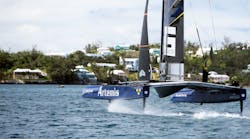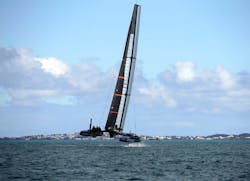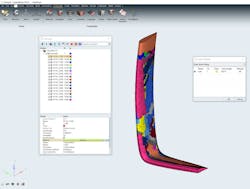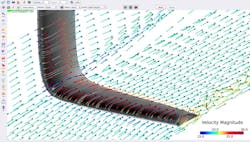The yachts that race for the America’s Cup have changed a lot since the first of these legendary races back in 1851, including going from single-hull racers to dual-hulled boats or catamarans a decade ago. But one of the most dramatic changes occurred about five years ago: the addition of specially shaped daggerboards that can be lowered and raised.
When just one of these L-shaped components are in the water, the 3-to-6 ft. airfoil on the bottom creates enough lift as it is pulled through the water to lift the entire boat (about a 3-ton load). The daggerboards also convert side forces into driving or forward-pointing forces. With the boat “flying” above the surface of the water, drag is substantially reduced and the boat’s speed increases dramatically. American Cup Class yachts now sail at up to 60 mph, four times faster than the single-hulled boats in the 2007 race.
The size, shape, and construction of these daggerboards are critical for winning the America’s Cup, so most race teams partner with a software company to help develop cutting-edge daggerboards. Team Artemis, which represents the Royal Swedish Yacht Club, partners with Altair, a design software and simulation company based in Troy, Mich.
Altair engineers applied the company’s HyperWorks software to the challenge of designing and building two sets of daggerboards for Team Artemis. One is for light wind conditions and the other’s for heavier winds. The boards for light winds are larger so they can generate enough lift at lower speeds. Some other teams opt for a single “all-weather” design that is a compromise between the two.
The choice of which approach to take—one or two sets of daggerboards—is not driven by FEA or optimization. It’s a strategic choice on the part of the teams. “Two boards might give you an advantage against a team with an all-weather board,” says David Durocher, an Altair engineer who worked with Team Artemis. “However this comes at the risk and cost of building backups for both boards.”
FEA does play a role, mainly to evaluate specific design ideas. Simulation is what allows Altair to come up with the final design quicker and more economically. “It is faster and much less expensive to build and run a simulation than to build and run tests on physical prototypes,” says Durocher. “And we can dramatically improve on this by automatically finding the best design idea using computational optimization tools.”
The Altair team used several modules of HyperWorks on the Artemis project: HyperMesh, for developing finite-element models of the complex carbon-fiber reinforced plastic composites uses to build the boards; OptiStruct, for analyzing and optimizing the structure of the boards; and Radioss, for analyzing the expected large, nonlinear deflections the boards would experience.
Nonlinear analysis is needed because it can account for both the loads the daggerboards or foils will see during a race when at high speed, which include compressive, twisting, and bending forces, and resulting large deflections. “Simpler and faster linear assumptions would develop a significant degree of error,” says Durocher.
“There are a lot of structural design challenges regarding the boards,” notes Durocher. “Two of the big ones are weight and targeted stiffness. The choices you have that drive stiffness are material layout, material type, metallic or composite, and within the composites, the orientation and stacking sequence of piles.
“Topology optimization and compose free size optimization tools inside OpticStruct, for example, helped find the lightest weight design that met all the strength, stiffness, and stability criteria,” he adds.
The boasts have two daggerboards, one at the midpoint of each of the hulls. The skipper of each boat has the leeway to control how far forward or back on the hull the daggerboards are (rake) and how far inward or outward (camber) they are to keep the boat stable. And only one daggerboard can be in the water at a time, except when sailing taking a turn and sailing the front or rear of the boat through the wind (tacking and jibing, respectively).
The boats cannot carry any powered devices; everything has to be moved by manual power. So several of the crew—usually large, muscular sailors referred to as grinders—spend most of their time turning cranks that power a hydraulic pump. Hydraulic power is then used to move various components, including raising and lowering the daggerboards.
“The boards are fully raised or fully lowered every time the boat tacks or jibes, maybe about 20 to 30 times per race,” says Durocher. “And it takes five to 10 seconds to do this.”
To handle all of the forces, the boards are made primarily of high-strength carbon fiber epoxy, which can handle large loads. “It’s the same material used on the wings and fuselages of the Boeing 787 Dreamliner,” explains Durocher. “And the 787 composite wings carry several hundred thousand pounds each—and for safety’s sake, are designed for much more.”
Although the composite absorbs some water and retains a small degree of moisture, it can be considered watertight but they retain a small degree of moisture inside of them. “Material properties are degraded in wet or hot conditions,” says Durocher. “But the effects of strength and stiffness are considered when designing them.”
One drawback to composites is that they can sometimes fail catastrophically without showing any signs of wear or fatigue beforehand. “Yes, composites will fail, and sometimes more violently than metals,” admits Durocher. “But that’s one reason the daggerboards, along with all other composite structures, are checked using ultrasound at the end of each day. If any damage is found, they are repaired. It’s far too expensive and time-consuming to replace them. Also, each team is limited to four daggerboards for the entire race series.”



